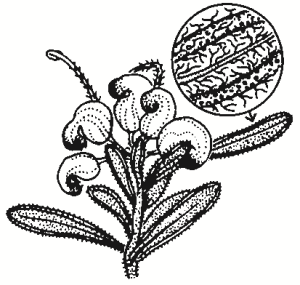Family:
Proteaceae
Grevillea lanigera
Woolly Grevillea
Other Names:
First Nations Name(s):

Name Origin:
Grevillea — after Charles Francis Greville (1749-1809), co-founder of London Horticultural Society.
lanigera — from Latin lana, wool, and gerus, bearing, referring to woolly leaves.
Regional Subspecies:
Occurrence:
Regional:
More common east of the Olympic Highway. Noted in the areas: Albury; Upper Back-Upper Jerra Jerra; Ardenside-Welaregang; Bringenbrong-Khancoban; Coreinbob; O’Briens South & McLeods; Upper Kyeamba; Keajura; Upper Burkes and Major. Possibly also in areas surrounding those noted.
Australia:
NSW, Vic.
Habitat:
Moist rocky places in light to heavy soil, including streambanks.
Habit:
Spreading shrub mostly 20 cm to 1.5 m high, with grey-green foliage.
Site Preference:
Well-drained soil. Tolerates frost and drought. Full sun or semi-shade.
Characteristics:
Apparently commonly hybridises with Rosemary Grevillea (G. rosmarinifolia). Also hybridises with Cat’s Claws Grevillea (G. alpina).
Flowering:
Variously red/pink/cream, mainly spring.
Seed Collection:
Summer. Fruits turn from green to brown and seeds shed soon after maturity, requiring close monitoring. Secure nylon stockings or paper bags to fruiting branches after flowering to ensure collection. Generally only small proportion of flowers set seed.
Propagation:
From cuttings 5-7 cm long with heels, which strike readily. Also from seed, which may result in variable plants.
Regeneration:
From seed.
VALUES:
Shade & Shelter:
Useful low-level cover in windbreaks.
Wildlife:
Good habitat. Flowers are attract nectar-feeding birds, particularly honeyeaters such as the Eastern Spinebill, and various native moths and butterflies. Foliage is good refuge and nesting sites for small birds, particularly honeyeaters.
Ornamental:
Attractive ornamental for screening, rockeries and groundcover. Prune regularly to promote bushiness. Enhance flowering and vigour by occasional and thorough summer watering.
